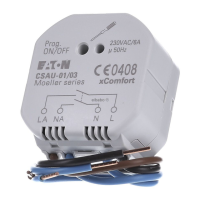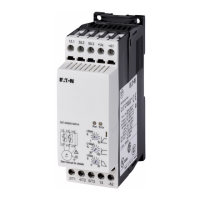6 In-/output configuration and parameterization
6.2 Interrupt processing
94 Modular PLCs XControl: XC-104-…, XC-204-…, XC-303-… 01/23 MN050005EN Eaton.com
6.2 Interrupt processing
When an interrupt occurs, the operating system executes the program orga-
nization unit (POU) linked to the interrupt source.
Local inputs I1 to I4 can be used as interrupt sources.
They can be configured with Device-> local _IOParameters.
Available settings:
• Int falling
• Int rising
• Int descending + rising
The POU called by the interrupt-event is always completely processed and
cannot be interrupted by a new interrupt. A new interrupt is only carried out
after the current interrupt has ended.
The interrupts are enabled in the RUN state of the CPU and inhibited in the
STOP state. Interrupt sources that are not enabled in the configuration will
not trigger an interrupt. If a POU is not assigned to an enabled interrupt
source, the interrupt is recognized and executed but without running a POU.
Frequent occurrence of an interrupt during program execution can cause the
programmed task time to time-out and result in a RESET being initiated by
the Watchdog.
Interrupts can be inhibited and re-enabled from the program. The functions
DisableInterrup and EnableInterrupt are provided for this purpose. A call
parameter in the XSOFT-CODESYS-3 software determines if an individual
interrupt or all interrupts are enabled or inhibited. Enabling of an inhibited
interrupt must be performed with the same parameter used to inhibit it.
Both the DisableInterrupt and EnableInterrupt functions are components
of the EA_XC303Events.lib. library. This library must – if not already done so
– be integrated into the library manager of the XSOFT-CODESYS-3, see
→ Section “16.2 Installing additional system libraries”, page 153.
DisableInterrupt
With this function, you disable (deactivate) a parameterized physical interrupt
by accessing it from the user program.
→
The execution of the interrupt POU is not time monitored.
Programmed infinite loops will not be exited!
ATTENTION
All the outputs controlled (H signals) up to this point remain
active and can't be switched off.

